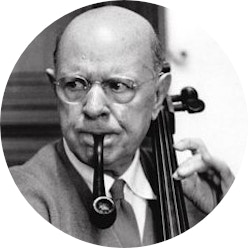
Pau Casals
December 29, 1876 - El Vendrell, Spain — October 22, 1973 - San Juan, Puerto Rico
Acerca de
The great Spanish cellist (and conductor), Pablo Casals (actually, Pau Carlos Salvador Defilló), legend has it, supported by Casals himself, that he was conceived when Johannes Brahms began his B-flat Major Quartet, of which Casals owned the original manuscript, and that he was born when J. Brahms completed its composition. This legend is rendered moot by the fact that the quartet in question was completed and performed before Casals was even born. But even the ascertainable facts of the life of Casals make it a glorious tale. His father, the parish organist and choirmaster in Vendrell, gave Casals instruction in piano, violin, and organ. When Casals was eleven, he first heard the cello performed by a group of traveling musicians, and decided to study the instrument. In 1888 his mother took him to Barcelona, where he enrolled in the Escuela Municipal de Música. There he studied cello with José García, theory with José Rodoreda, and piano with Joaquín Malats and Francisco Costa Llobera. His progress as a cellist was nothing short of prodigious, and he was able to give a solo recital in Barcelona at the age of fourteen, on February 23, 1891; he graduated with honors in 1893.
Pablo Casals was also a composer; perhaps his most effective work is La sardana, for an ensemble of cellos, which he composed in 1926. His oratorio El pessebre (The Manger) was performed for the first time in Acapulco, Mexico, on December 17, 1960. One of his last compositions was the Himno a las Naciones Unidas (Hymn of the United Nations); he conducted its first performance in a special concert at the United Nations on October 24, 1971, two months before his 95th birthday. On August 3, 1957, at the age of 80, Casals married his young pupil Marta Montañez; following his death, she married the pianist Eugene Istomin, on February 15, 1975. Casals did not live to see the liberation of Spain from the Franco dictatorship, but he was posthumously honored by the Spanish government under King Juan Carlos I, which issued in 1976 a commemorative postage stamp in honor of his 100th birthday.

